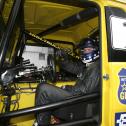Pressekontakt
ADAC e.V.
Oliver Runschke
Motorsport- und Klassik-Kommunikation
Tel.: +49 89 7676 6965
Mobil: +49 171 555 6236
E-Mail: oliver.runschke@adac.de
Kay-Oliver Langendorff
Leiter Partnerschaften, Kooperationen & Sponsoring
Leiter Kommunikation Motorsport & Klassik
Tel.: +49 (0)89-7676 6936
Mobil: +49 (0)171-555 5936
E-Mail: kay.langendorff@adac.de
12.07.2012 - ADAC GT Masters
Johannes Stuck: Race trucks great fun
- Aston Martin driver compares super sports cars and race trucks
- ADAC GT Masters to line up during ADAC Truck Grand Prix weekend
650bhp versus 1,500: Two different motor racing worlds meet head-on at the Nürburgring, July 13th to 15th, when the ADAC GT Masters takes place alongside the ADAC Truck Grand Prix that features race trucks contesting the FIA European Truck Championship. The ADAC GT Masters super sports car with up to 650bhp on tap and top speeds of 250km/h will encounter 1,500bhp race trucks limited to 160km/h at the Nürburgring. Johannes Stuck (25 A), last year’s ADAC GT Masters winner at the Nürburgring, is familiar with both the super sports cars and the race trucks; in 2011, the son of motor racing legend Hans-Joachim ‘Striezel’ Stuck competed in the League of Super Sports Cars and the ADAC Truck Grand Prix.
Sports car paddle shift as opposed to H setup in truck
“It has taken me a fair amount of time to be quick in a race truck,” says Stuck, who drives an Aston Martin V12 Vantage in the ADAC GT Masters prepared by Young Driver AMR. Stuck elaborates: “You have plenty of power in the race truck and a very different gearbox with dozens of gears. The truck has the traditional H pattern with the facility to switch between different ratios. The driver uses a rotary switch on the dashboard to change mechanically from low to high ratio and then a toggle switch on the shift lever to select a higher or lower gear.” Changing gear in the Aston Martin V12 Vantage during the ADAC GT Masters is much easier, since the 2011 ADAC GT Masters runner-up is able to select any one of six gears at the flick of a finger by means of paddles on the steering wheel.But the same degree of precision is demanded of drivers in both categories: “You have to steer, change gear and accelerate with the same precision in both ADAC GT Masters and Truck GP. You have to be very careful in the truck, though, since they have an enormous amount of torque, in excess of 5,000Nm.”
Tidy driving required, even in race truck
Apart from the gearbox, brake cooling is another peculiarity of the race trucks: the trucks have water-cooled brakes and a rotary switch in the cockpit to adjust the quantity of water used depending on brake temperature, and so you have to go easy given the limited amount of water on board. Stuck: “There are more things to do in the race truck but the speed is also much lower than in the ADAC GT Masters.” Another challenge in the race truck is the limiter set to 160km/h: “You reach top speed very quickly and then you are often on the limiter and for lengthy periods. As a result, the trucks are just as quick as one another along the straights, and you have to get ahead on the brakes and go for the best line out of the turn as well in order to take vital tenths of a second out of the opposition.”Tyre pressure, secret of success
Tyres are also different as compared to the ADAC GT Masters. Whereas drivers in the League of Super Sports Cars take to the grid on YOKOHAMA slicks, tyres that have a profile and are street legal are the order of the day on trucks. Stuck: “The truck tyres are too big and heavy to be changed during the race. Consequently, they do have a profile and are used in all weather conditions.” However, as regards tyres and setup, careful tweaking of tyre pressures is common to both GT sports cars and trucks: “Tyre pressures play an immensely important role in setup on the two vehicles.”After seeing double duty in the ADAC GT Masters and the Race Truck GP last year, Stuck is focused on the upcoming weekend and sharing the drive in the Aston Martin with his brother, Ferdinand (21 A), but: “Truck racing last year was tremendous fun, and even though I’m not actually in a truck this weekend, I will doubtless spend every spare minute following the truck racing events.”



